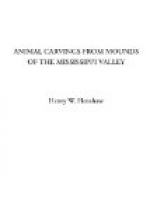THE “ALLIGATOR” MOUND.
Although of much less importance than the mastodon, a word may be added as to the so-called alligator mound, more especially because the alligator, owing to its southern habitat, is not likely to have been known to the Mound-Builders of Ohio. That it may have been known to them either through travel or hearsay is of course possible. A copy of the mound from the “Ancient Monuments” is subjoined.
The alligator mound was described under this name for no other reason than because it was known in the vicinity as such, this designation having been adopted by Squier and Davis, as they frankly say, “for want of a better,” adding “although the figure bears as close a resemblance to the lizard as any other reptile.” (Ancient Monuments, p. 99.)
In truth it bears a superficial likeness to almost any long-tailed animal which has the power of curling its tail—which, the alligator has not—as, for instance, the opossum. It is, however, the merest guess-work to attempt to confine its resemblances to any particular animal. Nevertheless recent writers have described this as the “alligator mound” without suggesting a word of doubt as to its want of positive resemblance to that saurian.
[Illustration: Fig. 30.—“Alligator” Mound.]
HUMAN SCULPTURES.
The conclusion reached in the foregoing pages that the animal sculptures are not “exact and faithful copies from nature,” but are imitations of a general rather than of a special character, such as comport better with the state of art as developed among certain of the Indian tribes than among a people that has achieved any notable advance in culture is important not only in its bearing on the questions previously noticed in this paper, but in its relation to another and highly interesting class of sculptures.
If a large proportion of the animal carvings are so lacking in artistic accuracy as to make it possible to identify positively only the few possessing the most strongly marked characters, how much faith is to be placed in the ability of the Mound sculptor to fix in stone the features and expressions of the human countenance, infinitely more difficult subject for portrayal as this confessedly is?
That Wilson regards the human sculptures as affording a basis for sound ethnological deductions is evident from the following paragraph, taken from Prehistoric Man, vol. 1, p. 461:
Alike from the minute accuracy of many of the sculptures of animals, hereafter referred to, and from the correspondence to well known features of the modern Red Indian suggested by some of the human heads, these miniature portraits may be assumed, with every probability, to include faithful representations of the predominant physical features of the ancient people by whom they were executed.
Short, too, accepting the popular idea that they are faithful and recognizable copies from nature, remarks in the North Americans of Antiquity, p. 98, ibid., p. 187:




